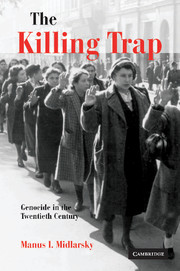Book contents
- Frontmatter
- Contents
- Preface
- PART I Introduction
- PART II Explaining perpetrators: theoretical foundations
- PART III The theory applied
- PART IV Victim vulnerability: explaining magnitude and manner of dying
- 10 Raison d'état, raison d'église
- 11 Cynical realpolitik and the unwanted
- 12 High victimization: the role of realpolitik
- 13 Inequality and absence of identification
- 14 On the possibility of revolt and altruistic punishment
- PART V Exceptions
- PART VI Conclusion
- References
- Index
12 - High victimization: the role of realpolitik
Published online by Cambridge University Press: 22 September 2009
- Frontmatter
- Contents
- Preface
- PART I Introduction
- PART II Explaining perpetrators: theoretical foundations
- PART III The theory applied
- PART IV Victim vulnerability: explaining magnitude and manner of dying
- 10 Raison d'état, raison d'église
- 11 Cynical realpolitik and the unwanted
- 12 High victimization: the role of realpolitik
- 13 Inequality and absence of identification
- 14 On the possibility of revolt and altruistic punishment
- PART V Exceptions
- PART VI Conclusion
- References
- Index
Summary
Consistent with the purpose of explaining the magnitude of the killing, the remaining chapters in this part focus initially on reasons for the high victimization rate in certain occupied countries during the Holocaust. Realpolitik is emphasized, followed by inequality and failures of mutual identification among the victims. This part of the book concludes with a comparison among Jewish ghettos in Eastern Europe and the reasons for revolt in one such ghetto, but a higher survival rate in another that did not revolt. Paradoxically, revolt and ultimate survival will prove to be independent of each other in these ghettos. Also, somewhat counterintuitively, individual and community survival will appear to be inconsistent with each other.
Two cases of high victimization now occupy our attention. Why should Hungary and the Netherlands stand out for the mass murder of high percentages of their Jewish populations, especially when Hungary was occupied by the Germans only very late in the war (March 1944), and the Netherlands had a uniquely tolerant social landscape that virtually eliminated the possibility of widespread anti-Semitism? What are the salient causes?
Hungary
The Holocaust in Hungary also conforms to the model of the contraction of socioeconomic space as a progenitor of anti-Semitic practice, but it was German brute force realpolitik that sealed the fate of 70 percent of Hungarian Jewry.
Prior to World War I, the Hungarians joined with the Austrians in administering the Austro-Hungarian Empire, a dual monarchy in which they jointly ruled the largest empire in East-Central Europe comprising today's Austria, Hungary, Czech Republic, Slovakia, Slovenia, Croatia, Bosnia-Herzegovina, and large swaths of southeastern Poland and western Ukraine, most notably Galicia. Hungarian Jews were increasingly “Magyarized” in their support of the Hungarian aristocracy.
- Type
- Chapter
- Information
- The Killing TrapGenocide in the Twentieth Century, pp. 250 - 263Publisher: Cambridge University PressPrint publication year: 2005



